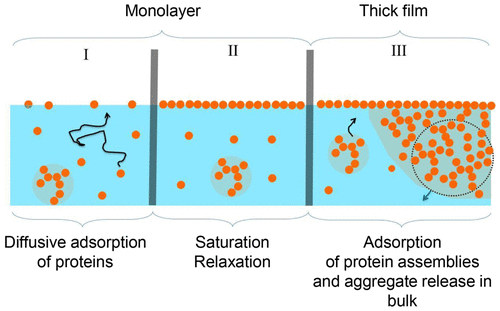Our official English website, www.x-mol.net, welcomes your
feedback! (Note: you will need to create a separate account there.)
Sunflower Proteins at Air–Water and Oil–Water Interfaces
Langmuir ( IF 3.7 ) Pub Date : 2021-02-18 , DOI: 10.1021/acs.langmuir.0c03441 Alexandre Poirier 1 , Antonio Stocco 1, 2 , Romain Kapel 3 , Martin In 1 , Laurence Ramos 1 , Amélie Banc 1
Langmuir ( IF 3.7 ) Pub Date : 2021-02-18 , DOI: 10.1021/acs.langmuir.0c03441 Alexandre Poirier 1 , Antonio Stocco 1, 2 , Romain Kapel 3 , Martin In 1 , Laurence Ramos 1 , Amélie Banc 1
Affiliation

|
The adsorption of a sunflower protein extract at two air–water and oil–water interfaces is investigated using tensiometry, dilational viscoelasticity, and ellipsometry. For both interfaces, a three step mechanism was evidenced thanks to master curve representations of the data taken at different aging times and protein concentrations. At short times, a diffusion limited adsorption of proteins at interfaces is demonstrated. First, a two-dimensional protein film is formed with a partition of the polypeptide chains in the two phases that depends strongly on the nature of the hydrophobic phase: most of the film is in the aqueous phase at the air–water interface, while it is mostly in the organic phase at the oil–water interface. Then a three-dimensional saturated monolayer of proteins is formed. At short times, adsorption mechanisms are analogous to those found with typical globular proteins, while strong divergences are observed at longer adsorption times. Following the saturation step, a thick layer expands in the aqueous phase and appears associated with the release of large objects in the bulk. The kinetic evolution of this second layer is compatible with a diffusion limited adsorption of the minor population of polymeric complexes with hydrodynamic radius RH ∼ 80 nm, evidenced in equilibrium with hexameric globulins (RH ∼ 6 nm) in solution. These complexes could result from the presence of residual polyphenols in the extract and raise the question of the role of these compounds in the interfacial properties of plant protein extracts.
中文翻译:

空气-水和油-水界面处的向日葵蛋白
向日葵蛋白提取物在空气-水和油-水两个界面上的吸附情况使用了张力测定法,膨胀粘弹性和椭偏法进行了研究。对于这两个界面,由于在不同的老化时间和蛋白质浓度下获取的数据的主曲线表示,证明了一种三步机制。在短时间内,证明了蛋白质在界面上的扩散受限吸附。首先,形成二维蛋白质膜,在两相中多肽链的分配在很大程度上取决于疏水相的性质:大多数膜在水-水界面处处于水相中,而大部分处于油水界面的有机相中。然后形成蛋白质的三维饱和单层。在短时间内,吸附机理与典型的球形蛋白质相似,而在较长的吸附时间观察到强烈的差异。在饱和步骤之后,厚层在水相中膨胀,并出现与大块物体释放相关的现象。第二层的动力学演化与少量流体动力学半径的聚合配合物的扩散受限吸附相容ř ħ〜80纳米,证明与六聚球蛋白(平衡- [R ħ在溶液中〜6纳米)。这些复合物可能是由于提取物中残留多酚的存在而引起的,并提出了这些化合物在植物蛋白提取物的界面特性中的作用问题。
更新日期:2021-03-02
中文翻译:

空气-水和油-水界面处的向日葵蛋白
向日葵蛋白提取物在空气-水和油-水两个界面上的吸附情况使用了张力测定法,膨胀粘弹性和椭偏法进行了研究。对于这两个界面,由于在不同的老化时间和蛋白质浓度下获取的数据的主曲线表示,证明了一种三步机制。在短时间内,证明了蛋白质在界面上的扩散受限吸附。首先,形成二维蛋白质膜,在两相中多肽链的分配在很大程度上取决于疏水相的性质:大多数膜在水-水界面处处于水相中,而大部分处于油水界面的有机相中。然后形成蛋白质的三维饱和单层。在短时间内,吸附机理与典型的球形蛋白质相似,而在较长的吸附时间观察到强烈的差异。在饱和步骤之后,厚层在水相中膨胀,并出现与大块物体释放相关的现象。第二层的动力学演化与少量流体动力学半径的聚合配合物的扩散受限吸附相容ř ħ〜80纳米,证明与六聚球蛋白(平衡- [R ħ在溶液中〜6纳米)。这些复合物可能是由于提取物中残留多酚的存在而引起的,并提出了这些化合物在植物蛋白提取物的界面特性中的作用问题。











































 京公网安备 11010802027423号
京公网安备 11010802027423号